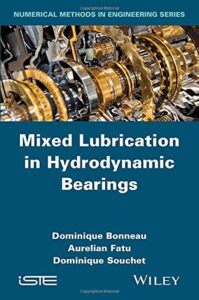Mixed Lubrication in Hydrodynamic Bearings
Mixed Lubrication in Hydrodynamic Bearings
Mixed Lubrication in Hydrodynamic Bearings is the second part of a four part book series dedicated to hydrodynamic bearings.The first volume describes the physical properties of lubricants that play an essential role within the hydrodynamic process; it then explains the equations of hydrodynamic lubrication as well as the models and numerical resolution. A description of “elastohydrodynamic” (EHD) models is also included in the contents of the first volume.
The numerical modeling of thin-film flows and the deformed walls which limit the film under pressure leads to the discretization of the domain occupied by the film by one of the methods described in the first volume. The more tortuous the boundary shape of the domain is, the finer the spatial discretization must be. From a sufficient distance, the surfaces that delineate the space occupied by the lubricant film appear smooth. If we retain the finite element method for the discretization of the equations, elements of only a few millimeters in size appear appropriate. However, fine profile measurements reveal flaws in the shape (plane, cylindrical, etc.) of the surfaces with amplitude of the order of micrometers and variable wavelengths ranging from a few tenths of micrometers to several millimeters.
You can also Read Internal Combustion Engine Bearings Lubrication in Hydrodynamic Bearings
Mixed Lubrication in Hydrodynamic Bearings Content
Cover
Title Page
Copyright
Contents
Preface
Nomenclature
Chapter 1: Introduction
1.1. Lubrication regimes
Stribeck curve
1.2. Topography of rough surfaces
1.2.1. 2D profile parameters
1.2.1.1. Definition of the reference height
1.2.1.2. Statistical treatment of the ordinate
1.2.1.3. Statistical treatment of the ordinate respective to the abscissa
1.2.1.4. Fractal analysis
1.2.2. Common standard profile parameters
Chapter 2 : Computing the Hydrodynamic Pressure
1.2. Topography of rough surfaces
1.2.1. 2D profile parameters
1.2.1.1. Definition of the reference height
1.2.1.2. Statistical treatment of the ordinate
1.2.1.3. Statistical treatment of the ordinate respective to the abscissa
1.2.1.4. Fractal analysis
Chapter 3 :Computing the Contact Pressure
3.3.1. Elasto-plastic constitutive law
3.3.2. Description of microgeometric properties of rough surfaces
3.3.2.1. Asperities’ radius
3.3.2.2. Distribution of asperities’ heights
3.3.3. Asperity deformation
3.3.3.1. Elastic deformation
Download

Comments are closed.